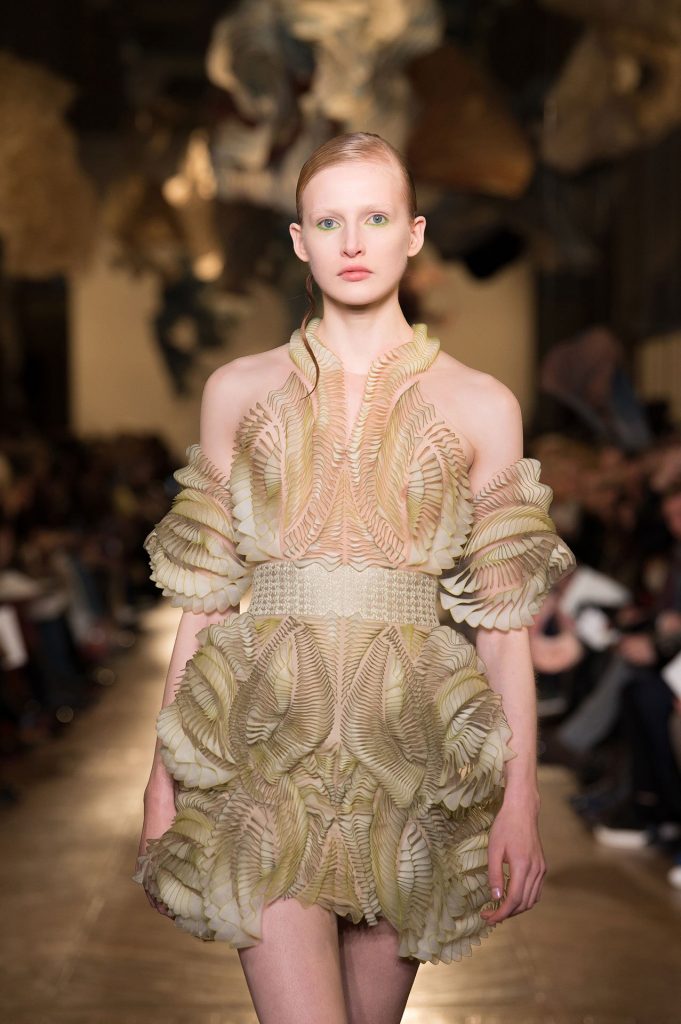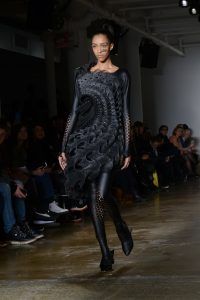Naomi Kaempfer is the Creative Director of Art, Fashion and Design for Stratasys. She has a wide background of experience within the 3D printing and fashion realm. Kaempfer specialises in 3D printing, art & design driven business strategies. She is a great resource of knowledge within the burgeoning 3D printing and fashion industry.
What got you interested in the combination of fashion and technology?
I studied Law and Philosophy and achieved a Bachelors in product engineering, MSc in Design Management. I specialized in bridging business strategies with international design and creative markets translating solutions from product design into non-standard architecture, among others. After working with ONL on the show for the NSA at Pompidou, I was asked to establish the design and art Platform for manufacturing, which was a novelty in the consumer market in 2003. This platform became the renowned *.MGX for Materialise. I directed this division for 7 years. From 2008-2011, I led as Chair professor “the LAB” the technology department at the Design Academy which was Directed by Lidewij Edelkoort at the time.Between 2010-2013, I drove the strategic design development of Delhaize Group as the Design Strategy Expert and worked as an independent consultant for 3D printing companies and emerging design platforms.I joined Stratasys in 2014 as Creative Director, Art, Fashion and Design – responsible for the build-up of the fashion, design and art collaborations at Stratasys. With the company’s R&D, we explore the possibilities of 3D printing cross border in the creative disciplines, and with its advanced technologies, we collaborate with designers and artists to stretch the creative envelope. I form our relationships and collaborations with museums, art and design institutions, the creative sector and art collectors. Throughout the years, I’ve set up numerous collections in collaboration with top artists and designers that have been presented at leading museums such as MoMA, V&A, Pompidou, MET, Smithsonian Cooper Hewitt, and many more.
Personally, I am interested in experimenting with clothing and this type of technology. What would you suggest a designer look into for rapid prototyping of their designs? What printing technologies and techniques are most viable for creating clothes?
This past year, we have been focused on developing PolyJet technology for directly 3D printing onto textiles. Our aspiration is to uncover how 3D printing can work in harmony with textiles and to discover how, in the future, we can continue to integrate new 3D printing solutions and materials into the fashion scope. With great support from our R&D team, this past year marked the first time that this has been achieved using our high-resolution PolyJet 3D printing technology – representing an exciting breakthrough for the industry. By combining traditional textile materials with digitally-created 3D printing materials, we’re utilizing the best of both worlds and enabling a faster integration of the technology in textile design.
Naomi Kaempfer and Gabi Asfour
Can you give some examples of recent projects you have worked on in terms of 3D Printing and fashion?
We have collaborated with Neri Oxman, Julia Koerner and Iris Van Herpen on different fashion projects in the past, and today, we are working with ThreeASFOUR, ZHA, Neri Oxman, Julia Koerner and other fashion designers in the creation of a new series of unique 3D printed dresses, shoes and fashion items. We have launched a new STARTS project Re-FREAM focusing on the field of 3D printed textiles for fashion (https://www.re-fream.eu/). In this project, we invite artists and designers to explore and seek solutions by integrating 3D printing, electronics and smart tech in textiles, and textile finishing into fashion.
Explain the potential 3D Printing has for the fashion industry as a whole.
The role of 3D printing in fashion is continually evolving, and we are seeing a notable increase in awareness and interest in the technology from various brands and designers. This growth in curiosity is coming from across the fashion spectrum – from high-end fashion to the low-end and in various fashion applications. We are researching the right design solutions and best product fit.
With 3D printing we are moving towards a textile being totally 3-dimensionally grown or embodying 3D elements. An inspiring example can be seen in Iris Van Herpen’s latest haute couture collection “Ludi Nature”. The foliage dress incorporates traditional textiles with 3D printed plastic elements utilizing Stratasys PolyJet technology. Three variations of the 3D printed material were altered on a droplet level, achieving the unique color and transparency on the dress which allows it to seamlessly fuse with the fabric material.
Our digital materials are offering up vast possibilities, as every element of a garment or textile can now have its own individual digitally defined physical properties. For example, you can create a specific textile that is waterproof, opaque, flexible or rigid, in different areas and patches of a single textile or garment.
Without the need for a specific mold, we are free to create intricate geometries and structures, which are color precise and aesthetically pleasing, while at the same time offer smart functionality.
The immense opportunities for customization that 3D printing offers is another important benefit for the industry. Apparels can now be created to perfectly fit the size, impact and curvature of each part of the body, allowing for true personalization.
What does your day-to-day schedule consist of in terms of being the Creative Art Director of Art Fashion Design at Stratasys?
Our way of building-up the creative platform at Stratasys involves the creation of collections, collaborations with designers and artists, exhibitions, deep technological research with our R&D team, and an outward communication activity to demonstrate the unique advances we’re making in art, design and fashion with 3D printing and the subsequent opportunity for designers. A usual day is a cross communication between the different involved parties, from business analysts, material researchers, curators, publishers, marketing people, our R&D and production teams.
It seems as though you sit on the edge of technology as well as art. Do you see these fields to be similar or very different? What advantages does someone have if they are able to be within both fields?
Art and technology are different fields in that they seek to answer very different questions and achieve different targets. The sometimes fantastical or utopian target we aim for in the arts helps us to explore unimaginable needs that lead us to great new learnings. These learnings tend to unveil a practical angle we have not considered before, which offers great technological and applicative gains when integrated within design. When we seek the cutting-edge either in design or art, we often reach a perspective offering a philosophical bind between these two domains.
Polyjet Printed Object by Stratasys
Where should one be focusing their skill set if they want to be a 3D designer?
A deep understanding of the practical, as well as the philosophical and conceptual properties of 3D software packages, is an important plus. Other than that, all knowledge of contemporary design is relevant, as well as consumer-based thinking, sensitivities of environment and social aspects, change of market dynamics and human behavior.
The general public is aware of 3D printing, but few are actually aware of how the fashion industry is leveraging it. What are some topic areas you would recommend for further study if one is interested in 3D printing and fashion?
3D printing within fashion is still a very uncharted domain, for us as well. We are researching this application together with different brands, who like us, wish to leverage the inherent benefits of the technology and find ways to enhance traditional fashion design.
What brands are interesting to you in terms of leveraging technology such as 3D Printing, along with fashion?
Our current focus is integrating 3D printing solutions in unique fashion needs, mostly in collaboration with high-segment brands, integrating complex geometries on textile, detailed color patterns, and customizable collections. We will start with limited size series, often from one-off for the movie industry, small series for high-end fashion, as well as for unique events and concerts. Unfortunately, at this stage we cannot disclose any specific details of projects we’re working on with collaborating brands, especially during the development phase. As soon as we are ready to share details, we will announce them publicly.
Lastly, what are your predictions when it comes to the future of the fashion industry as a whole?
We believe there will be further growth in garments that incorporate sophisticated physical properties embedded in specifically defined areas of the traditional textile. We also believe the ability to make customization cost-effective will also see 3D printing branch into other areas of fashion, such as leisure and sportswear, and potentially in cases of medical care.
Ultimately, we hope that the fashion world returns to a more sustainable model, which involves more localized production, allowing smaller design and production houses to compete in the market – 3d printing is an aid in localization. It will be fascinating to witness the evolving impact of 3D printing on the fashion domain and see how it continues to challenge and transform our perception of fashion. At Stratasys, we are very excited to see what impact future technological developments will have on the fashion domain and we remain very open to all 3D printing applications that might have a future contribution to the industry.
To find out more about Stratasys’ work within 3D printed art, design and fashion, please visit:
https://3dprintedart.stratasys.com/
Subscribe to Our Email Newsletter
Stay up-to-date on all the latest news from the 3D printing industry and receive information and offers from third party vendors.
Print Services
Upload your 3D Models and get them printed quickly and efficiently.
You May Also Like
Heating Up: 3D Systems’ Scott Green Discusses 3D Printing’s Potential in the Data Center Industry
The relentless rise of NVIDIA, the steadily increasing pledges of major private and public investments in national infrastructure projects around the world, and the general cultural obsession with AI have...
3DPOD 260: John Hart on VulcanForms, MIT, Desktop Metal and More
John Hart is a Professor at MIT; he´s also the director of the Laboratory for Manufacturing and Productivity as well as the director of the Center for Advanced Production Technologies....
Etsy Design Rule Change Reduces Selection of 3D Printed Goods
Online marketplace Etsy has implemented a rule change requiring all 3D printed goods on the site to be original designs. The update to the site’s Creativity Standards states, ¨Items produced using...
E-Beam OEM Wayland Additive Partners with USC Racing to 3D Print Titanium Exhaust Collector
Every year, standards organization SAE International holds a competition called Formula SAE, in which students from both undergraduate and graduate programs design, build, and race small formula-style race cars. For...







































